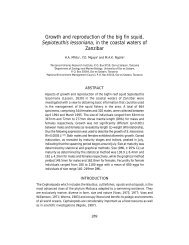gpa_east_africa_case.. - GRID Africa GeoPortal - UNEP
gpa_east_africa_case.. - GRID Africa GeoPortal - UNEP
gpa_east_africa_case.. - GRID Africa GeoPortal - UNEP
You also want an ePaper? Increase the reach of your titles
YUMPU automatically turns print PDFs into web optimized ePapers that Google loves.
Sewerage ManagementSewerage management institutionsPresently, the wastewater of Seychelles are managed through various laws and administeredby different departments. The division of responsibilities can be very briefly defined as follows:• The Public Utilities Corporation (PUC). All centralised sewerage systems in Seychellesare controlled by PUC, a government parastatal responsible for the provision of adequatesanitation for the people of Seychelles on the basis of the PUC Act of 1985.• The Division of Environment is responsible for conservation and protection of theenvironment, including responsibility for monitoring of the quality of both liquid and solidwastes, and waste water effluents and sludge disposal.• The Ministry of Health through its Environmental Health Division has the responsibility formonitoring and improving hygiene conditions in the country, advising and educating thepublic on good sanitary practices, and controlling the quality of portable water. A HealthInspector stationed at each of the local health centres throughout the country carries outmonitoring and inspections and also responds to people’s complaints on any health andsanitation related problems.Financing mechanismsSewerage tariffs are established uniformly for the whole country. The present tariff, which islinked to the water tariff covers only the operation and maintenance costs of the existingsewerage schemes. The government is presently meeting the cost of capital investments.Based on PUC guidelines commercial and industrial developments will be required to havetheir own sewage pre-treatment plants, so as to ensure that effluent discharges fromenterprises into public sewers conform to stipulated standards. This will facilitate the efficientoperation of the system, which is primarily designed to handle domestic sewage.Expected development trendsThe present population density is 22 inhabitant/ha, with future projects, population andtourism growth a figure of 40 inhabitants/ha is expected by the year 2010.Total population equivalent1994 2002 2010Residents *1 6501 7617 8924Future urban growth 1223 1432Tourism *2 1183 2138 2633Total 7684 10988 12989Source: SOGREAH, 1996*1 Calculated using a growth rate of 2%*2 Two person per room and a mean annual occupation rate of 85% are assumedVolume of wastewaterfor population equivalent that could be connected to the centralised sewerage system2002 2010Domestic population 6405 7504Tourist (85% occupancy rate) 2079 2633Total 8484 10137Rated discharged m3/d 1662 2020BOD kg/d 480 583SS kg/d 590 717Oil, grease kg/d 192 233The wastewater will be treated in two stages, for 6000 population equivalent in stage 1 and12000 population equivalent in stage 2 by the year 2010. This represents a respectivedischarge of 1200 kl/day and 2400 kl/day.Population Projections for greater Beau VallonYear Ha 2002 2010Population equivalent 301 7,617 8,924Final Draft Report – Cost Benefit Case StudiesGPA Strategic Action Plan on Sewage, October, 200096


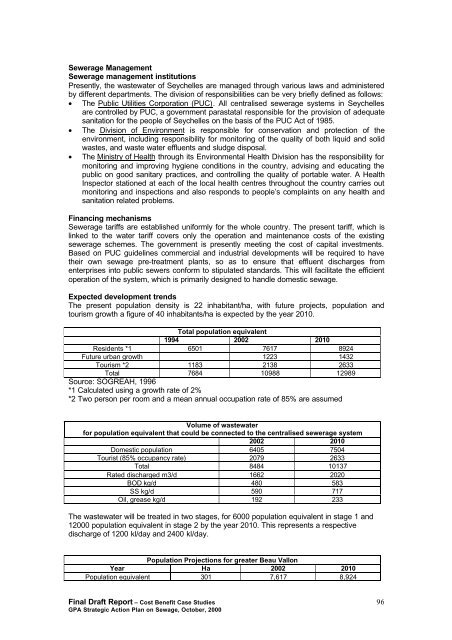
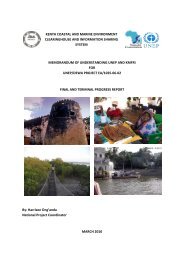

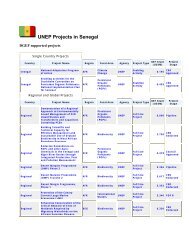

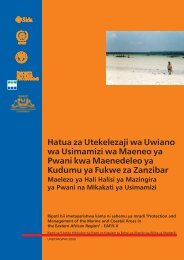
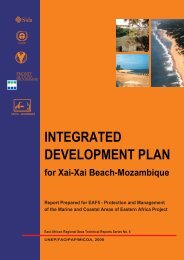

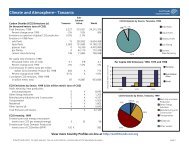

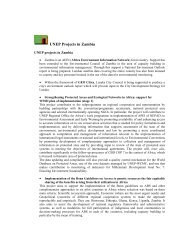
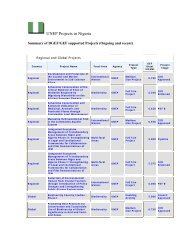
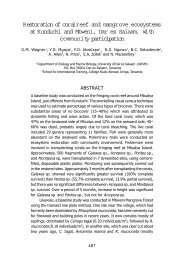
![Please Click to download [English] - GRID Africa GeoPortal - UNEP](https://img.yumpu.com/30633391/1/184x260/please-click-to-download-english-grid-africa-geoportal-unep.jpg?quality=85)
